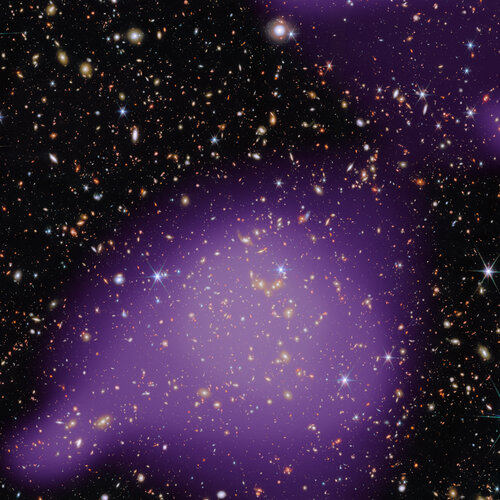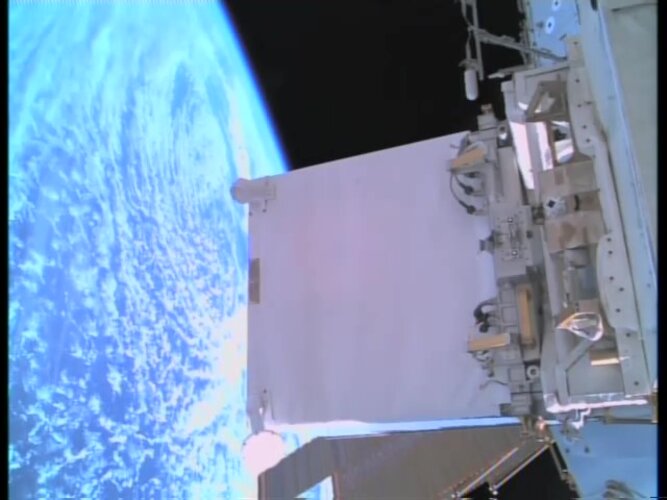NASA deploys UAVSAR flights to map snowmelt and refine water resource forecasting
Wednesday, 30 April 2025 10:48 RIn a mission to deepen understanding of one of Earth's most vital resources, NASA's C-20A aircraft completed seven specialized research flights in March, gathering critical data on snowmelt processes and freshwater availability. Equipped with the Uninhabited Aerial Vehicle Synthetic Aperture Radar (UAVSAR), the aircraft collected precise measurements of seasonal snow cover to estimate the fresh
RIn a mission to deepen understanding of one of Earth's most vital resources, NASA's C-20A aircraft completed seven specialized research flights in March, gathering critical data on snowmelt processes and freshwater availability. Equipped with the Uninhabited Aerial Vehicle Synthetic Aperture Radar (UAVSAR), the aircraft collected precise measurements of seasonal snow cover to estimate the fresh U.S. Space Force Deploys New Research Payloads to ISS for Technological Advancements
Wednesday, 30 April 2025 10:48 The U.S. Space Force's (USSF) Space Systems Command (SSC), working alongside NASA, has successfully launched the Space Test Program-Houston 10 (STP-H10) mission, delivering six cutting-edge experimental payloads to the International Space Station (ISS) aboard SpaceX's Commercial Resupply Service (CRS)-32 mission.
A collaborative effort involving SSC, NASA, the U.S. Naval Research Laborator
The U.S. Space Force's (USSF) Space Systems Command (SSC), working alongside NASA, has successfully launched the Space Test Program-Houston 10 (STP-H10) mission, delivering six cutting-edge experimental payloads to the International Space Station (ISS) aboard SpaceX's Commercial Resupply Service (CRS)-32 mission.
A collaborative effort involving SSC, NASA, the U.S. Naval Research Laborator Space Systems Command bolsters satellite processing for future launches
Wednesday, 30 April 2025 10:48 The United States Space Force's Space Systems Command (SSC) has awarded a National Security Space Launch (NSSL) Space Vehicle Processing Commercial Solutions Opening (CSO) contract to Astrotech Space Operations (ASO), aiming to enhance commercial satellite processing capabilities at Vandenberg Space Force Base in California by 2028.
"This $77.5 million CSO award is a public-private partner
The United States Space Force's Space Systems Command (SSC) has awarded a National Security Space Launch (NSSL) Space Vehicle Processing Commercial Solutions Opening (CSO) contract to Astrotech Space Operations (ASO), aiming to enhance commercial satellite processing capabilities at Vandenberg Space Force Base in California by 2028.
"This $77.5 million CSO award is a public-private partner Space Systems Command and NRO launch Phase 3 mission under new contract
Wednesday, 30 April 2025 10:48 The U.S. Space Force's Space Systems Command (SSC), in collaboration with the National Reconnaissance Office (NRO), has successfully completed the launch of the NROL-145 mission aboard a SpaceX Falcon 9 rocket. Liftoff occurred at 5:29 a.m. from Space Launch Complex 4 East at Vandenberg Space Force Base in California.
The mission marks a significant milestone as the NROL-145 launch was sec
The U.S. Space Force's Space Systems Command (SSC), in collaboration with the National Reconnaissance Office (NRO), has successfully completed the launch of the NROL-145 mission aboard a SpaceX Falcon 9 rocket. Liftoff occurred at 5:29 a.m. from Space Launch Complex 4 East at Vandenberg Space Force Base in California.
The mission marks a significant milestone as the NROL-145 launch was sec Vega-C takes Biomass to the sky
Wednesday, 30 April 2025 09:59 Video:
00:08:17
Video:
00:08:17
ESA’s state-of-the-art Biomass satellite has launched aboard a Vega-C rocket from Europe’s Spaceport in French Guiana. The rocket lifted off on 29 April 2025 at 11:15 CEST (06:15 local time).
In orbit, this latest Earth Explorer mission will provide vital insights into the health and dynamics of the world’s forests, revealing how they are changing over time and, critically, enhancing our understanding of their role in the global carbon cycle. It is the first satellite to carry a fully polarimetric P-band synthetic aperture radar for interferometric imaging. Thanks to the long wavelength of P-band, around 70 cm, the radar signal can
Biomass launch highlights
Tuesday, 29 April 2025 15:30 Video:
00:02:59
Video:
00:02:59
ESA’s state-of-the-art Biomass satellite launched aboard a Vega-C rocket from Europe’s Spaceport in Kourou, French Guiana. The rocket lifted off on 29 April 2025 at 11:15 CEST (06:15 local time).
In orbit, this latest Earth Explorer mission will provide vital insights into the health and dynamics of the world’s forests, revealing how they are changing over time and, critically, enhancing our understanding of their role in the global carbon cycle. It is the first satellite to carry a fully polarimetric P-band synthetic aperture radar for interferometric imaging. Thanks to the long wavelength of P-band, around 70 cm, the
Biomass launched to count forest carbon
Tuesday, 29 April 2025 09:30
ESA’s groundbreaking Biomass satellite, designed to provide unprecedented insights into the world’s forests and their crucial role in Earth’s carbon cycle, has been launched. The satellite lifted off aboard a Vega-C rocket from Europe’s Spaceport in Kourou, French Guiana, on 29 April at 11:15 CEST (06:15 local time).
Replay: Biomass launch coverage
Tuesday, 29 April 2025 09:30 Video:
01:54:04
Video:
01:54:04
ESA’s state-of-the-art Biomass satellite launched aboard a Vega-C rocket from Europe’s Spaceport in Kourou, French Guiana. The rocket lifted off on 29 April 2025 at 11:15 CEST (06:15 local time).
In orbit, this latest Earth Explorer mission will provide vital insights into the health and dynamics of the world’s forests, revealing how they are changing over time and, critically, enhancing our understanding of their role in the global carbon cycle. It is the first satellite to carry a fully polarimetric P-band synthetic aperture radar for interferometric imaging. Thanks to the long wavelength of P-band, around 70 cm, the
ESA’s Biomass mission launches on Vega-C
Tuesday, 29 April 2025 08:30 Video:
00:02:01
Video:
00:02:01
ESA’s state-of-the-art Biomass satellite has launched aboard a Vega-C rocket from Europe’s Spaceport in French Guiana. The rocket lifted off on 29 April 2025 at 11:15 CEST (06:15 local time).
In orbit, this latest Earth Explorer mission will provide vital insights into the health and dynamics of the world’s forests, revealing how they are changing over time and, critically, enhancing our understanding of their role in the global carbon cycle. It is the first satellite to carry a fully polarimetric P-band synthetic aperture radar for interferometric imaging. Thanks to the long wavelength of P-band, around 70 cm, the
A visual feast of galaxies, from infrared to X-ray
Tuesday, 29 April 2025 07:00 Image:
Webb: A visual feast of galaxies, from infrared to X-ray
Image:
Webb: A visual feast of galaxies, from infrared to X-ray Mission control GO for Biomass launch
Monday, 28 April 2025 14:00 Image:
Mission control GO for Biomass launch
Image:
Mission control GO for Biomass launch Ignis science
Monday, 28 April 2025 13:57
ESA project astronaut Sławosz Uznański-Wiśniewski will conduct a variety of science experiments and technology demonstrations during the Ignis mission. While the International Space Station is a home away from Earth for astronauts, it is, above all, a state-of-the-art laboratory in orbit. Its unique microgravity environment allows researchers to study phenomena that are impossible to replicate on our planet.
ACES in space
Monday, 28 April 2025 12:30 Image:
Image:
The Atomic Clock Ensemble in Space (ACES), ESA’s state-of-the-art timekeeping facility, is now installed on the Columbus laboratory of the International Space Station. This still image, captured by external cameras on the Station, shows ACES after installation. For 25 years, cameras on the Station have documented activities in orbit, providing real-time views of operations like this one – a rare and remarkable perspective from space.
On 25 April, the Canadian Space Agency’s robotic arm carefully extracted ACES from the SpaceX Dragon trunk and secured it onto the Columbus External Payload Facility, next to ESA’s space storm hunter ASIM
Upcoming ESA–Industry events prepare for Ministerial Council 2025
Monday, 28 April 2025 10:40
The European Space Agency (ESA) invites the industrial community to several events where ESA directorates will communicate and coordinate with industry on their proposals and intentions in relation to its Council Meeting at Ministerial Level (CM25) in November.

